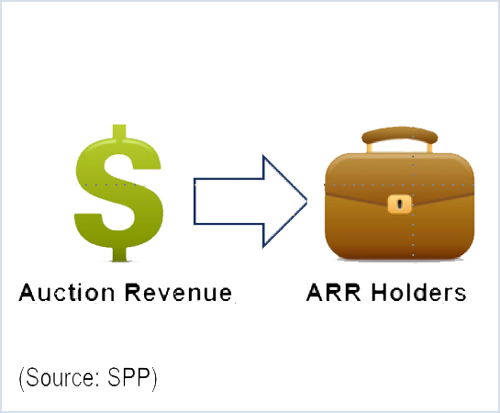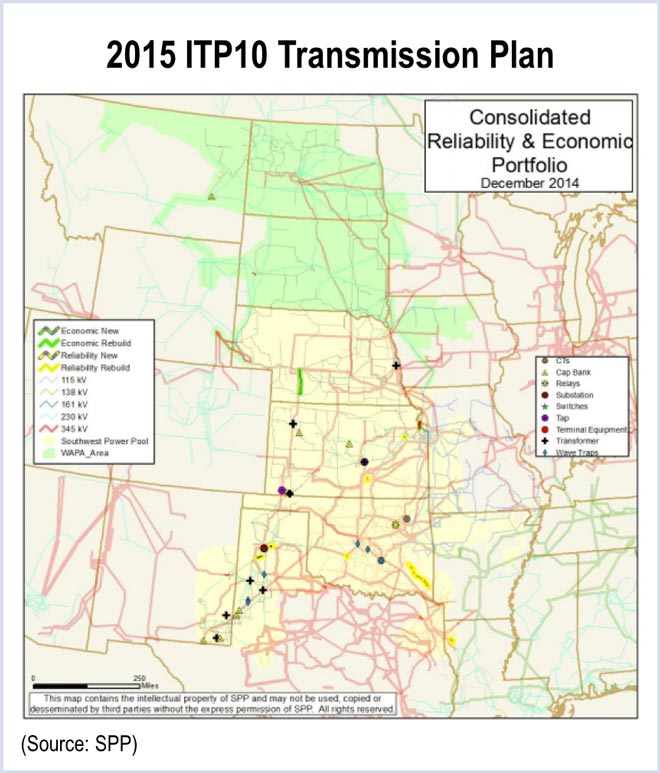KANSAS CITY — SPP’s Markets and Operations Policy Committee voted last week to change the annual auction revenue rights allocation system capacity to better match the annual transmission congestion rights (TCR) auction and reduce underfunding.

Those pushing the 60% allocation for seasonal months said it was an aggressive number and would solve the TCR markets’ underfunding problem, but they recognized it would cause problems for some market participants.
SPP “staff felt it was really struggling to get this change in,” said Debbie James, SPP’s manager of market design. “While 80% is an incremental improvement, we really need to get rid of the carry forward. We need to match them up.” (Unsettled ARRs are carried forward to be settled in the monthly processes.)
In opposing the original 60% allocation, Xcel Energy’s Bill Grant said, “We thought 100% to 60% was overkill. Eighty percent is probably a better number in our minds.”
“I’m leery about making a change on the fly,” said Bill Dowling of Midwest Energy. “Eighty percent will still mitigate the problem, but it’s not a perfect fix.”
An ARR is a financial right that entitles the holder to a share of the auction revenues generated in the TCR auctions or the right to convert them into TCRs. ARRs were originally designed to be allocated in the annual process, meaning the full system capacity was allocated and only new entitlements were offered in the monthly allocation. In 2012, however, FERC required the monthly process be available to all existing candidate ARRs. However, updates to the full annual allocation were not made after the FERC order, resulting in the mismatch between percentages of ARRs and percentages of TCRs.
Under the current market design, ARRs are allocated based on 100% of system capacity, while TCRs are primarily awarded at 60% to 90%. That has made annual ARRs infeasible, as less available capacity is carried forward to the monthly processes. Many of the previously infeasible annual ARRs are still infeasible in the monthly process. Infeasible capacity held by these ARRs is guaranteed through limit expansion and goes to either the ARR holder as an ARR self-convert or another TCR auction participant.
The MWG recommendation will settle or convert all annual ARRs during the annual process. No ARRs would be carried forward, and infeasible TCRs would be reduced. All residual capacity would still be allocated and auctioned in monthly processes.
The MOPC had an easier time approving the MWG’s Revision Request 93 (Market Registration and Timeline Changes), which cleans up Tariff language and makes it easier to dispatch generation in the SPP footprint, and RR 99 (STRUC With QS Carve Out), which provides more accurate operational information than the current intraday reliability unit commitment process.
The MOPC approved another nine RRs recommended by the MWG as part of the consent agenda, along with four RRs from other working groups.
2017 ITP10 Update
ITC Great Plains’ Alan Myers, chair of the Economic Studies Working Group, updated the MOPC on the group’s work on the 2017 Integrated Transmission Planning 10-Year Assessment, just two months into its 18-month cycle.

Myers told members the ITP10 will implement new criteria for modeling future resources, defining bounds around specific resources stakeholders can submit for inclusion in ITP10 and ITP20 studies.
The 2017 study will also rank constrained flowgates’ congestion costs. Up to 25 constraints — with a minimum of $50,000 in annual congestion each — will be identified as economic needs.
The study will use financial advisory firm Lazard’s 2014 Levelized Cost of Energy Analysis, as well as other metrics such as 2012 hourly wind profiles; Department of Energy growth rates and NYMEX futures for natural gas prices; and ABB’s North American Electric Reliability Corp. data for coal, oil and uranium prices.
The ESWG has completed a load and generation review and a survey of anticipated renewable energy mandates and goals. It is currently working on developing the ITP10’s scope and futures, various resource plans and building an economic model.
The model will assume SPP’s 13.6% reserve margin, and 5% and 10% accreditation for future wind and solar resources, respectively.
The study will use three futures revolving around a regional Clean Power Plan solution: one assuming the rule’s regional implementation, a second assuming state-by-state implementation and a third assuming business as usual. Each future also assumes competitive wind, plentiful natural gas (due to hydraulic fracturing), normal load growth and large-scale solar generation development.
Prioritizing Revision Requests
The MOPC approved the creation of a more formal process for prioritizing RRs, including a scoring system and facilitated quarterly discussions open to all stakeholders. If approved by the board, the process would begin with the first two quarterly cycles of 2016.
“This will be transparency stakeholders have never had before,” said Xcel Energy’s Grant, the chair of the Stakeholder Prioritization Task Force, which recommended the changes.
Grant said the new prioritization process would not evaluate projects that don’t clear the working group process. The process would use a standardized scoring tool to rate RRs and enhancements, including capital projects and RRs initially scored by SPP staff and working groups. The results would be tabulated in a portfolio report listing projects, RRs, enhancements, defects and associated data (priority scores, initial cost estimates and target implementation dates).
An open stakeholder meeting would be held each quarter to discuss the report; an updated portfolio and written meeting summary would be published for each MOPC meeting. The committee would review and discuss during its regular member forum.
The SPTF’s proposal addresses a request for stakeholders’ increased transparency and input into the prioritization process.
The MOPC also approved the task force’s request to extend its charter an additional year. “We want to stick around long enough to make sure the process is providing the desired stakeholder input,” Grant said.
RCAR Remedies
The Regional Allocation Review Task Force updated the MOPC on its work on a business practice to correct imbalanced cost allocations. Potential remedies would be added to the Tariff as part of SPP’s Regional Cost Allocation Review (RCAR).
American Electric Power’s Richard Ross, the task force vice chair, said the RCAR II analysis needs to be completed by October 2016. That requires, in turn, transmission topology updates to the RCAR models be completed by Oct. 1, 2015, and member commitment to provide the necessary help.
“We need creative solutions, because the process is not working as well as it was intended,” Ross said.
SPP staff has been developing a strawman business practice in coordination with SPP’s Regional State Committee, documenting remedies and clarifying their implementation. Remedy requests and any changes to the business practice would go to the RARTF.
The business practice comes in response to FERC’s rejection of a February 2015 filing that would have added remedies to Attachment J of the Tariff.
Xcel Energy protested the filing, asking the commission to reject the proposed remedies and have SPP develop modifications to the existing methodology for new transmission projects. Rather than refile, the RARTF directed SPP staff to create a strawman business practice.
Transmission Planning Improvement Update
The Transmission Planning Improvement Task Force reported good progress since its formation in the spring. The team has met four times, said Jason Atwood of Northeast Texas Electric Cooperative, with a goal of making transmission planning’s model building, transmission assessment and engineering services “bigger, better and quicker.” It will spend the next few months looking at futures, scenarios and sensitivities.
The task force is discussing whether to conduct the 10-year, near-term and transmission-planning assessment studies at the same time in an 18-month overlapping process, which would produce study results on an annual basis. Atwood noted an annual basis could provide more accuracy.
Wind, Solar Ratings Unchanged
The Generation Working Group recommended no changes to SPP’s methodology for establishing net capability for wind and solar facilities. SPP currently requires that wind resources’ ratings correspond to the load-serving members’ peak hours. The GWG’s data indicate that the value varies from 5% to more than 50%, dependent upon location and timing of peak load.
“This confirms the methodology that the wind resource’s planning capability should be based both on location and tied to load,” the GWG’s report said. The report also confirmed the current default value of 5% used for facilities in commercial operation for three years or less “is reasonable.”
Charter Revisions OK’d in Preparation for Integrated System
The MOPC approved charter revisions for five working groups, allowing them to add Integrated System representation when the IS joins SPP on Oct. 1. Business Practices will go from 10 to 12 members, Economic Studies from 14 to 18, Operating Reliability from 12 to 17, Operations Training from 11 to 15 and Reliability Compliance from 15 to 17.
The committee also approved a name change for the Reliability Compliance Working Group — subbing “regional” for “reliability” — accurately reflecting the group’s purpose and scope. It also gave the go-ahead to a revised scope for the Economic Studies Working Group to allow for additional reviews and approvals of items that align with its knowledge base and current Tariff processes.
‘Incredible Improvement’ in Reliability
Noting a continued decreased trend in violations, Ron Ciesiel, general manager of SPP’s Regional Entity, reported to the MOPC only one category 1 event — a loss of an hour or more of monitoring or control at a control center — was analyzed in the second quarter.
Ciesiel also said the SPP RE has completed its ninth consecutive quarter without a vegetation-contact report. SPP was the last region in the NERC to report a contact, in the first quarter of 2013.
Ciesiel also noted that there are some days in which NERC has no reportable incidents in all of North America.
“That is an incredible improvement from where we were eight years ago,” he said.
— Tom Kleckner



